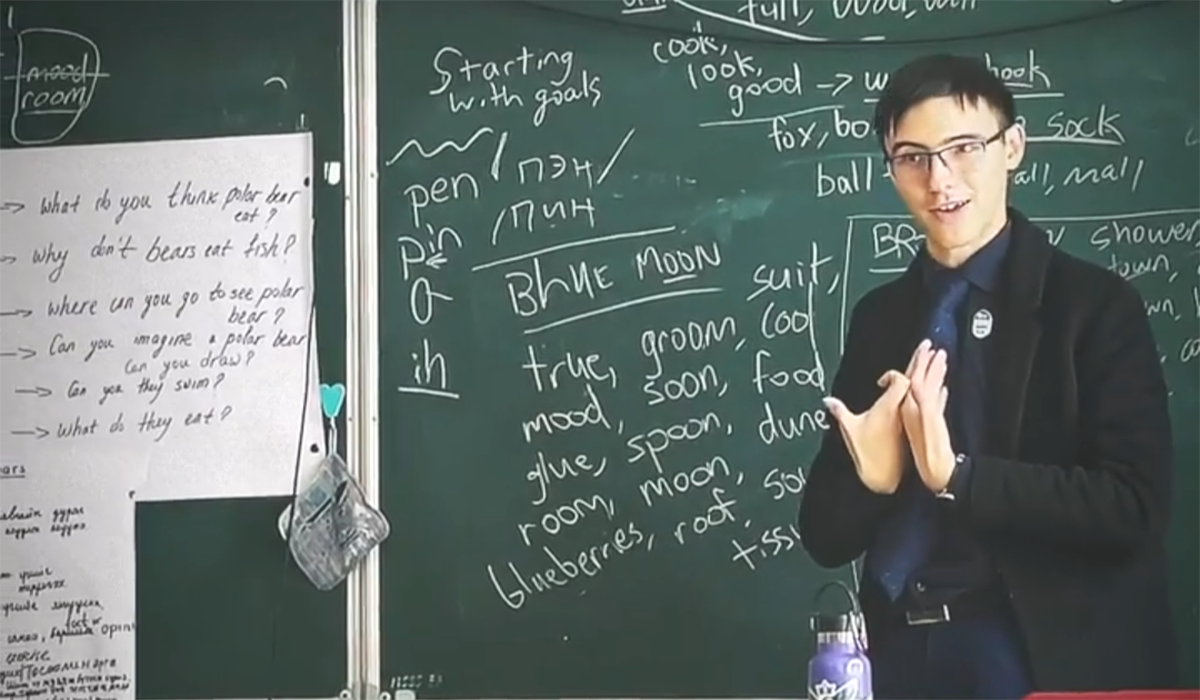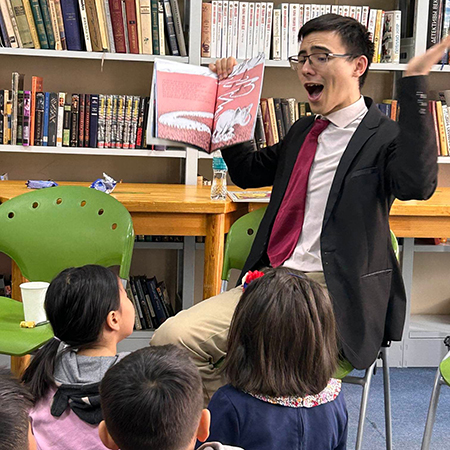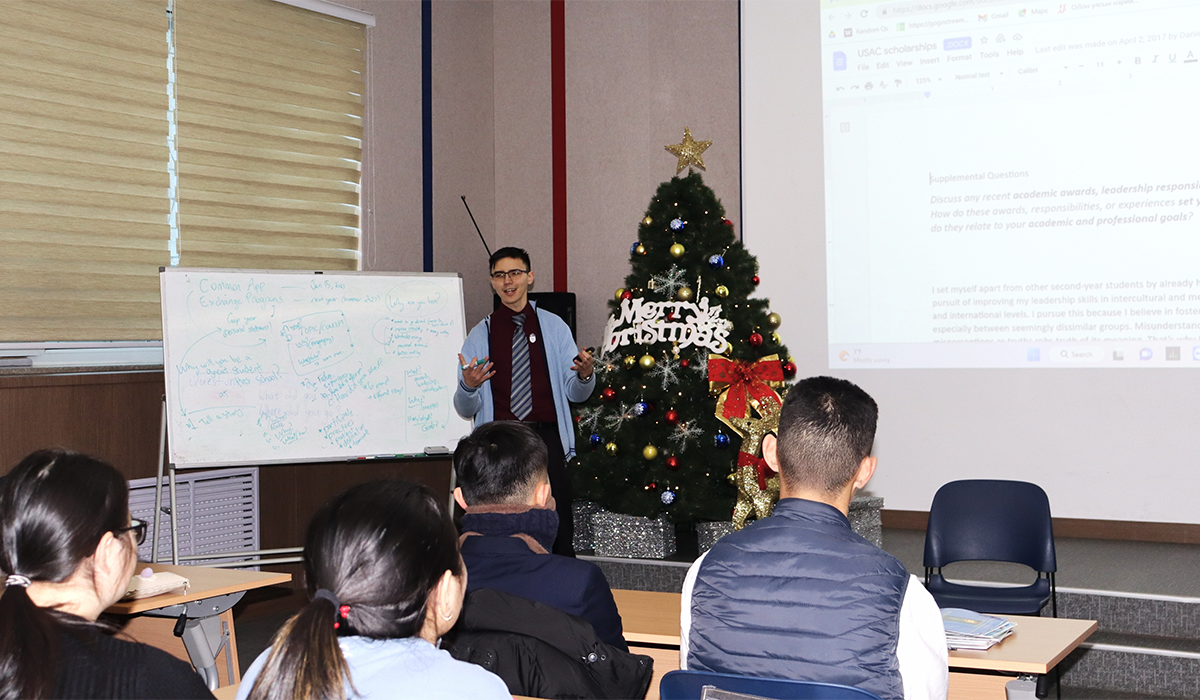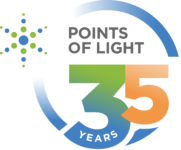Peace Corps Volunteer Bridges Cultures Through Education

Meet Daily Point of Light Award honoree Daniel Lindbergh Lang. Read his story, and nominate an outstanding volunteer or family as a Daily Point of Light.
When 28-year-old Daniel Lindbergh Lang first heard about the Peace Corps as a college freshman, he never imagined it would define his path. Years later, that early curiosity led him to Mongolia—twice—where he became not just an English educator, but a cultural bridge-builder, mentor and lifelong advocate for global understanding.
A two-time Peace Corps Volunteer fluent in English, Mongolian and Chinese, Daniel served in Mongolia from 2019–2020 and again from 2022–2024. There, he strengthened English education, mentored hundreds of students and teachers and helped revitalize Peace Corps operations post-pandemic. Now, as executive director of the National Peace Corps Association’s Friends of Mongolia affiliate and co-founder of the LinYL Foundation, Daniel continues to champion education, service and connection across cultures.
What first inspired you to volunteer with the Peace Corps?
I first heard about the Peace Corps during my freshman year of university, but it wasn’t until a few years later—when I was abroad on a U.S. State Department program—that it really stuck. A friend and I were talking with high school students studying Mandarin, encouraging them to keep going, and their resident director happened to be a returned Peace Corps volunteer.
When I got back to campus, I realized two of my professors were also Peace Corps alums. Suddenly, I was surrounded by people whose lives had been shaped by service abroad. Their encouragement pushed me to apply. I was very fortunate to receive an invitation to Mongolia. I had to pack up, spend two years in a country I’d never been to and learn a language that I’d never learned before.

For those who may not know, what is the Peace Corps’ mission, and what was your role in Mongolia?
The Peace Corps has three main goals. The first is to provide skilled volunteers to communities that invite them. I worked in English education and community development.
The second is cultural exchange. As a volunteer, I wasn’t just there to teach English—I was there to learn from the people around me, to understand Mongolian culture and to become part of the community.
The third goal is about bringing those experiences back home. Now that I’m back in the U.S., I see that as my ongoing mission—sharing stories about Mongolia, the people I met and everything I learned.
What did a typical day look like for you while serving?
It’s hard to describe a “typical” day, but one of my favorite parts of the week was working at the Teacher’s Development House in Ulaanbaatar, the capital city. I had a desk next to my main counterpart, the foreign language methodologist who oversaw English instruction for about 300 schools. Together, we conducted teacher development activities—consulting with teachers, organizing monthly workshops and helping improve classroom techniques.
Outside of that, I led creative writing sessions at the American Corner, a section of the public library where students and professionals came for English help. I especially loved helping people with their personal statements because I enjoyed getting to read people’s stories, but also help them tell it in the best way that can help them apply to universities or jobs. I also spent time working with students with special needs and collaborating with local schools and community centers.
Was there a particular person or project that left a lasting impact on you?
Oh, goodness, so many great memories. The main person I worked with was the foreign language methodologist, Nyamsuren Sainjargal. We started at the education department around the same time, figuring things out together and supporting one another through new challenges.
In our second year, the mayor of Ulaanbaatar initiated a city-wide English competition, and our department was tasked with leading it. Together, we launched what became the first annual English language contests for students and teachers—public speaking, book debates and teaching methodology competitions.
We also helped Mongolian teachers present at international English conferences in South Korea and Japan. Seeing my colleague continue those initiatives after I left—sending more teachers abroad and sustaining those programs—was incredibly rewarding.
You’re now executive director of the National Peace Corps Association Friends of Mongolia group. What does that involve?
I’ve been in the role about a month, and I’m definitely doing my best to make the most of it.
This organization brings together the nearly 30 years’ worth of volunteers who have served in Mongolia. After the pandemic, a lot of those connections went quiet, so my goal is to revitalize the network—bring in the newest returned volunteers while reconnecting with the earliest ones.
I’m building a small team, including some Mongolian Americans, to help organize socials, promote cultural events and share information about Mongolian studies here in the U.S. The hope is that when someone finishes their Peace Corps service in Mongolia, they’ll know exactly where to find community and continue engaging cross-culturally.
Tell me about the LinYL Foundation, which you co-founded with your siblings.
The LinYL Foundation started after our mother passed away. We wanted to honor her legacy in a way that would keep her spirit alive, and education felt like the most natural choice. She grew up in China during the Cultural Revolution, a time when education was limited. But she worked her way into one of China’s top universities and chose to pursue English—a rare path in the 1980s. She later became an English professor, which eventually led her to the United States to study international relations.
Her story shaped our family’s belief that language and education open doors. So, my siblings and I decided to pay that forward. We began offering scholarships for high school students going to college and later added a fund for students studying abroad.
Five years later, we’ve awarded more than $28,000 in scholarships to 36 students. Some of our first recipients have now graduated and are mentoring the newer ones, which is incredibly special. We recently celebrated the fifth anniversary of the foundation and what would have been my mother’s 60th birthday. Getting to reconnect with our scholarship recipients was really special. It was humbling to see them impart wisdom to each other and I felt my mom’s presence there in those times.

What’s been the most rewarding part of your volunteer work?
I really like the random thank-yous and connections that you could never predict. Those moments — the serendipitous ones — really feel great. Before I left Mongolia, there was a student who helped me co-facilitate the writing program I mentioned earlier. After she graduated high school, she found an opportunity to study abroad in the United States. When she returned to Mongolia, she continued teaching writing workshops to other students in the community. It amazed me that she kept up that same drive, that same passion we had started together.
And it’s not just her. I still hear from colleagues and students — little updates about what they’re doing, what opportunities they found through the things we worked on. Just this past weekend, one of my colleagues from the education department came all the way to Washington, D.C., for a conference, and one of my former students messaged me that she was also in the U.S. for a program. It just reminds me that we’re all part of this wonderful web — we don’t always know what impact we might have, but when it comes back to you in these unexpected ways, it really does put a pep in your step.
What advice do you have for others interested in volunteering?
Start local. My first service experiences were in Key Club and National Junior Honor Society. From there, I joined Kiwanis and other service groups. Even now, I volunteer with the Knights of Columbus at my parish in D.C.—sometimes that just means stacking chairs after an event, but it all matters.
And for anyone drawn to international work, the Peace Corps is still alive and thriving. Two years might sound like a long commitment, but even two hours a week can make a real difference. Service doesn’t have to be grand—it just has to be genuine.
What do you hope people take away from your story?
I hope they see kindness. That’s how I’d want to be remembered.
Whether it’s smiling at a neighbor, sharing your time or stepping outside your comfort zone, kindness goes a long way. My faith and my upbringing taught me to live with gratitude—and I believe gratitude is where service really flows from. The ease with which we can give comes from knowing how much we have received.
Do you want to make a difference in your community like Daniel? Find local volunteer opportunities.
